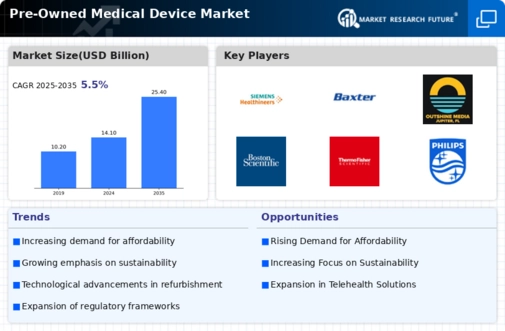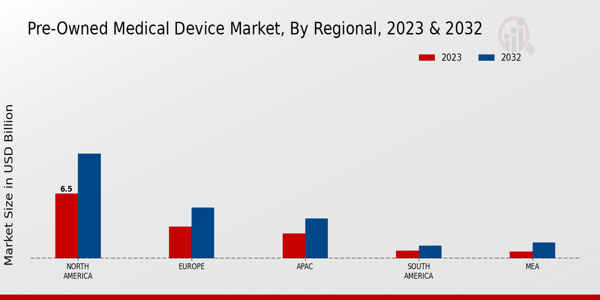Market Growth Projections
The Global Pre-Owned Medical Device Market Industry is poised for substantial growth, with projections indicating a market value of 25.4 USD Billion by 2035. This growth trajectory is supported by a compound annual growth rate of 5.52% from 2025 to 2035, reflecting the increasing acceptance and integration of pre-owned devices within healthcare systems. The market's expansion is driven by various factors, including rising demand for cost-effective solutions, technological advancements in refurbishment, and regulatory support. As healthcare providers continue to seek innovative ways to manage costs while maintaining quality, the pre-owned medical device sector is likely to play an increasingly vital role in the global healthcare landscape.
Increasing Focus on Sustainability
The Global Pre-Owned Medical Device Market Industry is witnessing a shift towards sustainability as healthcare organizations prioritize environmentally friendly practices. The reuse of medical devices significantly reduces waste and the carbon footprint associated with manufacturing new equipment. This growing emphasis on sustainability aligns with global initiatives aimed at reducing environmental impact. As a result, the pre-owned medical device sector is gaining traction, appealing to organizations committed to eco-friendly practices. The market's growth is further supported by the projected compound annual growth rate of 5.52% from 2025 to 2035, indicating a robust future for sustainable medical solutions.
Growing Global Healthcare Infrastructure
The expansion of healthcare infrastructure globally is a significant driver for the Global Pre-Owned Medical Device Market Industry. As countries invest in healthcare facilities, particularly in emerging markets, the demand for medical equipment, including pre-owned devices, is on the rise. This trend is particularly pronounced in regions where budget constraints limit the acquisition of new equipment. The pre-owned market offers a practical solution, allowing healthcare providers to equip their facilities effectively. The anticipated market growth to 14.1 USD Billion in 2024 highlights the increasing reliance on pre-owned devices as a means to enhance healthcare delivery in developing regions.
Regulatory Support for Refurbished Devices
Regulatory bodies are increasingly recognizing the importance of pre-owned medical devices, leading to supportive policies that facilitate their use. The Global Pre-Owned Medical Device Market Industry benefits from clearer guidelines and standards that ensure the safety and efficacy of refurbished equipment. Such regulatory support fosters confidence among healthcare providers, encouraging them to consider pre-owned options as viable alternatives. This trend is likely to enhance market growth, as evidenced by the projected increase in market value to 25.4 USD Billion by 2035. As regulations evolve, the acceptance of refurbished devices is expected to rise, further solidifying their role in the healthcare landscape.
Rising Demand for Cost-Effective Solutions
The Global Pre-Owned Medical Device Market Industry experiences a notable increase in demand for cost-effective medical solutions. Healthcare providers are increasingly seeking budget-friendly alternatives to new equipment, particularly in developing regions where financial constraints are prevalent. The pre-owned medical devices offer significant savings, allowing facilities to allocate resources more efficiently. This trend is underscored by the projected market value of 14.1 USD Billion in 2024, which indicates a growing acceptance of refurbished devices. As hospitals and clinics prioritize cost management without compromising quality, the pre-owned sector is likely to flourish, contributing to the overall growth of the industry.
Technological Advancements in Refurbishment
Technological advancements play a pivotal role in enhancing the quality and reliability of pre-owned medical devices. The Global Pre-Owned Medical Device Market Industry benefits from innovations in refurbishment processes, which ensure that devices meet stringent safety and performance standards. Enhanced testing and certification protocols have emerged, allowing refurbished equipment to compete effectively with new devices. This trend is reflected in the anticipated growth of the market, projected to reach 25.4 USD Billion by 2035. As healthcare facilities increasingly recognize the value of high-quality refurbished devices, the industry is likely to see a surge in demand, driven by improved technological capabilities.














